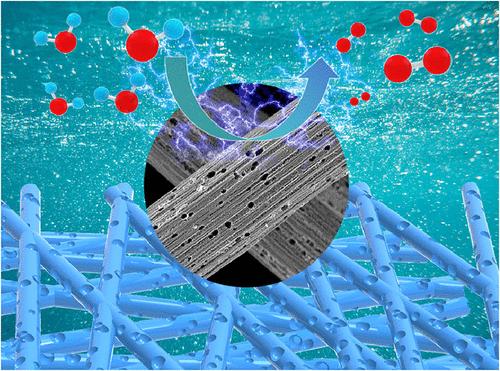Lattice Defects Coupled with Support Modification Enable a BiNi-Co3O4/CP Catalyst for High-Efficiency Acidic Oxygen Evolution Reaction
IF 8.2
2区 材料科学
Q1 MATERIALS SCIENCE, MULTIDISCIPLINARY
引用次数: 0
Abstract
Lattice defect engineering and support modification are effective strategies for modulating catalyst electronic structures and enhancing the intrinsic activity. This study reports the in situ synthesis of a Bi and Ni codoped Co3O4 catalyst on carbon paper (BiNi-Co3O4/CP) via a one-step molten salt method, integrating dual strategies. Bi doping, with its larger atomic radius, induces abundant lattice defects in the Co3O4 surface, optimizing the electronic structure of Co active sites and markedly boosting the inherent catalytic activity. Concurrently, the synergistic interaction between Ni and Bi facilitates the formation of a tailored porous carbon support, which increases the active site exposure and promotes bubble desorption. In situ diffuse reflectance infrared Fourier transform spectroscopy (DRIFTS) confirms that the formation of the *OOH intermediate is significantly lowered by BiNi-Co3O4/CP, as is interfacial water adsorption. In 0.5 M H2SO4 solution, the BiNi-Co3O4/CP catalyst demonstrates outstanding performance for the acidic oxygen evolution reaction (OER), achieving an ultralow overpotential of 275 mV at 10 mA cm–2 with 110 h stability. This work establishes the synergistic “lattice defect-support modification” approach as a paradigm for designing acidic OER electrocatalysts with high efficiency and stability.

晶格缺陷与载体修饰使bni - co3o4 /CP催化剂能够进行高效的酸性析氧反应
晶格缺陷工程和支架改性是调节催化剂电子结构和提高催化剂本征活性的有效策略。本研究报道了一种Bi和Ni共掺杂Co3O4催化剂(bni -Co3O4/CP)在碳纸上的一步熔盐法原位合成,整合了双重策略。Bi的原子半径更大,在Co3O4表面产生了丰富的晶格缺陷,优化了Co活性位点的电子结构,显著提高了其固有的催化活性。同时,Ni和Bi之间的协同作用有助于形成定制的多孔碳载体,从而增加活性位点暴露并促进气泡解吸。原位漫反射红外傅立叶变换光谱(DRIFTS)证实,BiNi-Co3O4/CP显著降低了*OOH中间体的形成,界面水吸附也显著降低。在0.5 M H2SO4溶液中,BiNi-Co3O4/CP催化剂表现出优异的酸性析氧反应(OER)性能,在10 mA cm-2下达到275 mV的超低过电位,稳定时间为110 h。这项工作建立了协同的“晶格缺陷-支持修饰”方法,作为设计高效稳定的酸性OER电催化剂的范例。
本文章由计算机程序翻译,如有差异,请以英文原文为准。
求助全文
约1分钟内获得全文
求助全文
来源期刊

ACS Applied Materials & Interfaces
工程技术-材料科学:综合
CiteScore
16.00
自引率
6.30%
发文量
4978
审稿时长
1.8 months
期刊介绍:
ACS Applied Materials & Interfaces is a leading interdisciplinary journal that brings together chemists, engineers, physicists, and biologists to explore the development and utilization of newly-discovered materials and interfacial processes for specific applications. Our journal has experienced remarkable growth since its establishment in 2009, both in terms of the number of articles published and the impact of the research showcased. We are proud to foster a truly global community, with the majority of published articles originating from outside the United States, reflecting the rapid growth of applied research worldwide.
 求助内容:
求助内容: 应助结果提醒方式:
应助结果提醒方式:


